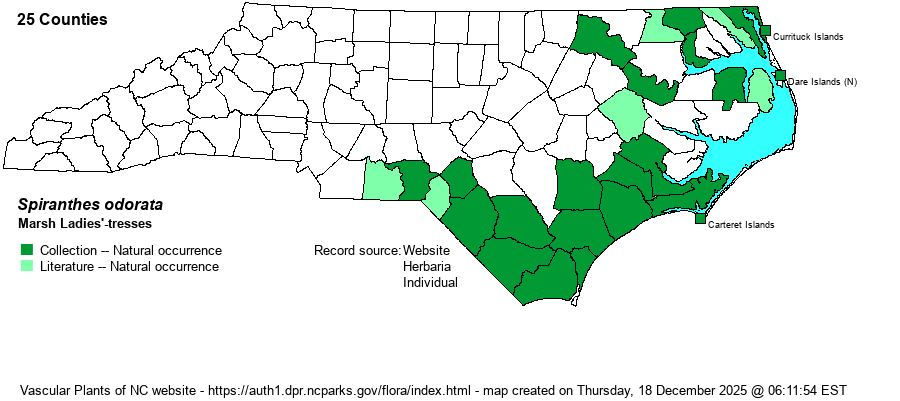| Author | (Nuttall) Lindley | |
| Distribution | Occurs essentially only in the Coastal Plain, generally throughout but rare to absent from part of the western Coastal Plain, barely entering the Sandhills region. There is a recent (2020) photo record by Becky Dill in iNaturalist for Anson County, in the lower Piedmont. There are several specimens from Sandhills counties -- Richmond and Scotland -- but need careful ID check; the editors have not added them to the range map, as confusion with S. cernua (strict sense) is likely. Known to range inland to Hertford, Martin, and Anson counties -- for now skipping over the Sandhills counties except Hoke (swamp on Fort Bragg).
This Southern species ranges from southeastern VA to southern FL and west to eastern TX. It ranges well inland to KY, much of TN, AR, and southeastern OK. | |
| Abundance | Generally uncommon in the southeastern counties, but rather rare north of Craven County. Very rare in the southeastern Piedmont (one site). Known to be present on some barrier islands, but mostly historical there. Not nearly as rare as the S2 rank by the NC NHP, and the website editors suggest S3. | |
| Habitat | This species typically grows in wet (but not simply "moist") habitats, often in some standing water. It is found mainly in swamps and marshes, but it is not a savanna species. | |
| Phenology | As with several species from the former S. cernua complex, it blooms in the fall, generally from September into November. Fruits shortly after flowering. | |
| Identification | This is a medium-to-tall Spiranthes, growing to around 1-2 feet tall, with a very tight spiral of small white flowers, as with many other ladies'-tresses. However, this species can generally be separated from others in the genus by its growing in quite wet habitats -- marshes and swamps. It also has several basal leaves that persist through the flowering period; they are broad and with rounded tips, wider than found in most other species in the genus -- giving it a "leafier" appearance than essentially all other Spiranthes found in NC. The top of the lip may often have some yellow or green, though this presence or absence of color is not overly helpful to identify the species. As can be seen from the map, this is a species of ladies'-tresses that a biologist can find on his or her own; it is not considered as rare by the NC NHP. | |
| Taxonomic Comments | Until recently, this taxon had been included within S. cernua (as have quite a few other "new" species), as S. cernua var. odorata. Most recent references seem to elevate it to full species status. As the scientific name implies, the flowers are fragrant, though some other Spiranthes are, as well.
| |
| Other Common Name(s) | Fragrant Ladies'-tresses | |
| State Rank | S2 [S3] | |
| Global Rank | G5 | |
| State Status | | |
| US Status | | |
| USACE-agcp | OBL link |
| USACE-emp | OBL link |

